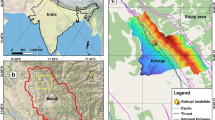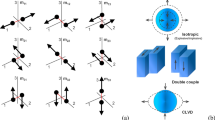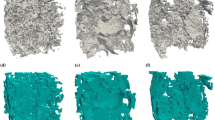Abstract
At impact with water, the velocity and thickness of a landslide are the key factors that govern momentum transfer and wave generation. These properties are not only a function of the size of the slide, but also a function of the landslide material, grain size, pore fluid, and other rheological parameters. The objective of this study is to determine the amplitude of waves generated from realistic landslides composed of both granular material and pore fluid in comparison with the waves generated by end-member landslides composed of only dry granular material or only fluid. To achieve this, laboratory experiments are conducted in a large-scale landslide flume and observations are collected using high-speed digital cameras and wave probes. Different source materials consisting of dry granular material, saturated granular material, and water are released down the landslide slope into the reservoir to generate impulse waves. The waves are analyzed to determine the amplitude and shape, and the effective time and length scales over which each landslide generates a wave. The observations are used to develop a mobility factor for all three landslide types based on the linear relationship between the length of forcing and the time of wave release. The measurements are compared to a predictive momentum-based relationship, and a modified equation is developed to account for the bulk mobility of the landslide. The improved equation can be applied to predict the maximum wave amplitude generated by a wide range of conditions for realistic landslides.













Similar content being viewed by others
Data Availability
The data used in this research are archived in the Queen’s University Dataverse repository (https://borealisdata.ca/dataverse/queens). The FM experiments reported by Bullard et al. (2019a, b) are downloadable from Take, W.A.; Mulligan, R.; Bullard, Gemma, 2019, “Queen’s Landslide Tsunami Flume Dataset—Water Impulse Waves”, https://doi.org/10.5683/SP2/DREGYG, Scholars Portal Dataverse, V1. The DG and SG experiments conducted in the present study are downloadable from Bullard, G.K.; Mulligan, R.P.; Take, W.A., 2023, “Queen’s Landslide Tsunami Flume Dataset – Impulse waves created by dry and saturated granular flows”, https://doi.org/10.5683/SP3/IQRXNX, Borealis.
References
Armanini A (2013) Granular flows driven by gravity. J Hydraul Res 51(2):111–120
Bougouin A, Paris R, Roche O (2020) Impact of fluidized granular flows into water: implications for tsunamis generated by pyroclastic flows. J Geophys Res: Solid Earth, 125:e2019JB018954.https://doi.org/10.1029/2019JB018954
Bullard GK, Mulligan RP, Carreira A, Take WA (2019a) Experimental analysis of tsunamis generated by the impact of landslides with high mobility. Coast Eng 152:103538
Bullard GK, Mulligan RP, Take WA (2019b) An enhanced framework to quantify the shape of impulse waves using asymmetry. J Geophys Res: Oceans 124(1):652–666
Bullard GK, Mulligan RP, Take WA (2023) Queen’s landslide tsunami flume dataset – impulse waves created by dry and saturated granular flows. https://doi.org/10.5683/SP3/IQRXNX (Borealis)
Coombs SP, Apostolov A, Take WA, Benoît J (2020) Mobility of dry granular flows of varying collisional activity quantified by smart rock sensors. Can Geotech J 57(10):1484–1496
Cruden DM, Varnes DJ (1996) Landslide types and processes. In: Turner AK, Schuster RL (eds) Landslides investigation and mitigation. Transportation research board, US National Research Council. Special Report 247, Washington, DC, Chapter 3, 36–75
de Lange SI, Santa N, Pudasaini SP, Kleinhans MG, de Haas T (2020) Debris-flow generated tsunamis and their dependence on debris-flow dynamics. Coast Eng 157:103623
Forterre Y, Pouliquen O (2008) Flows of dense granular media. Annu Rev Fluid Mech 40(1):1–24
Fritz HM, Hager WH, Minor HE (2003) Landslide generated impulse waves. Exp Fluids 35(6):505–519
Fritz HM, Hager WH, Minor HE (2004) Near field characteristics of landslide generated impulse waves. J Waterw Port Coast Ocean Eng 130(6):287–302
Heller V, Hager WH (2010) Impulse product parameter in landslide generated impulse waves. J Waterw Port Coast Ocean Eng 136(3):145–155
Hungr O (1995) A model for the runout analysis of rapid flow slides, debris flows, and avalanches. Can Geotech J 32(4):610–623. https://doi.org/10.1139/t95-063
Hungr O, Leroueil S, Picarelli L (2014) The Varnes classification of landslide types, an update. Landslides 11:167–194
Hürlimann M, Rickenmann D, Medina V, Bateman A (2008) Evaluation of approaches to calculate debris-flow parameters for hazard assessment. Eng Geol 102(3–4):152–163
Iverson RM (1997) The physics of debris flows. Rev Geophys 35(3):245–296
Lee CH, Huang Z (2022) Effects of grain size on subaerial granular landslides and resulting impulse waves: experiment and multi-phase flow simulation. Landslides 19(1):137–153
Lindstrøm EK (2016) Waves generated by subaerial slides with various porosities. Coast Eng 116:170–179
Lun CKK, Savage SB (1986) The effects of an impact velocity dependent coefficient of restitution on stresses developed by sheared granular materials. Acta Mech 63(1):15–44
McDougall S (2016) 2014 Canadian Geotechnical Colloquium: landslide runout analysis—current practice and challenges. Can Geotech J 54(5):605–620
Medina V, Hürlimann M, Bateman A (2008) Application of FLATModel, a 2D finite volume code, to debris flows in the northeastern part of the Iberian Peninsula. Landslides 5:127–142. https://doi.org/10.1007/s10346-007-0102-3
Meng Z, Hu Y, Ancey C (2020) Using a data driven approach to predict waves generated by gravity driven mass flows. Water 12(2):600
Mergili M, Fischer JT, Krenn J, Pudasaini SP (2017) r.avaflow v1, an advanced open-source computational framework for the propagation and interaction of two-phase mass flow. Geosci Model Dev 10:553–569
Miller GS, Take WA, Mulligan RP, McDougall S (2017) Tsunamis generated by long and thin granular landslides in a large flume. J Geophys Res: Oceans 122:653–668. https://doi.org/10.1002/2016JC012177
Mulligan RP, Franci A, Celigueta MA, Take WA (2020) Simulations of landslide wave generation and propagation using the particle finite element method. J Geophys Res: Oceans 125(6):e2019JC015873
Mulligan RP, Take WA (2017) On the transfer of momentum from a granular landslide to a water wave. Coast Eng 125:16–22
Pudasaini SP, Mergili M (2019) A multi-phase mass flow model. J Geophys Res Earth Surf 124(12):2920–2942
Rauter M, Hoße L, Mulligan RP, Take WA, Løvholt F (2021) Numerical simulation of impulse wave generation by idealized landslides with OpenFOAM. Coast Eng 165:103815
Robbe-Saule M, Morize C, Bertho Y, Sauret A, Hildenbrand A, Gondret P (2021) From laboratory experiments to geophysical tsunamis generated by subaerial landslides. Sci Rep 11(1):1–9
Stanier SA, Blaber J, Take WA, White DJ (2015) Improved image-based deformation measurement for geotechnical applications. Can Geotech J 53(5):727–739
Steers LJ (2018) Static liquefaction of loose granular landslides (Master’s Thesis). Queen’s University
Take WA, Mulligan R, Bullard G (2019) Queen’s landslide tsunami flume dataset – water impulse waves. https://doi.org/10.5683/SP2/DREGYG (Scholars Portal Dataverse, V1)
Taylor-Noonan AM, Bowman ET, McArdell BW, Kaitna R, McElwaine JN, Take WA (2022) Influence of pore fluid on grain-scale interactions and mobility of granular flows of differing volume. J Geophys Res Earth Surf 127(12):e2022JF006622
Tayyebi SM, Pastor M, Stickle MM (2021) Two-phase SPH numerical study of pore-water pressure effect on debris flows mobility: Yu Tung debris flow. Comput Geotech 132:103973
Zitti G, Ancey C, Postacchini M, Brocchini M (2015) Impulse waves generated by snow avalanches falling into lakes. In Proceedings of 36th IAHR World Congress, The Hague, Netherlands, 2015 (No. EPFL-CONF-215899). IAHR
Zitti G, Ancey C, Postacchini M, Brocchini M (2017) Snow avalanches striking water basins: behaviour of the avalanche’s centre of mass and front. Nat Hazards 88(3):1297–1323
Funding
Funding for this research was provided by Natural Sciences and Engineering Research Council of Canada (NSERC) under the Discovery Grant program awarded to W.A. Take (RGPIN/04245‐2015) and R.P. Mulligan (RGPIN/04043–2018).
Author information
Authors and Affiliations
Corresponding author
Ethics declarations
Conflict of interest
The authors declare no competing interests.
Supplementary Information
Below is the link to the electronic supplementary material.
Rights and permissions
Springer Nature or its licensor (e.g. a society or other partner) holds exclusive rights to this article under a publishing agreement with the author(s) or other rightsholder(s); author self-archiving of the accepted manuscript version of this article is solely governed by the terms of such publishing agreement and applicable law.
About this article
Cite this article
Bullard, G.K., Mulligan, R.P. & Take, W.A. Landslide tsunamis: exploring momentum transfer to waves generated by a range of materials with different mobility impacting water. Landslides 20, 2619–2633 (2023). https://doi.org/10.1007/s10346-023-02126-3
Received:
Accepted:
Published:
Issue Date:
DOI: https://doi.org/10.1007/s10346-023-02126-3




